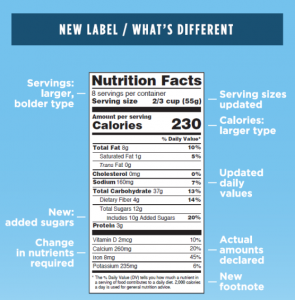The FDA recently enacted new rules for food labels. The rules go into effect on July 26, 2018 for manufacturers with sales over $10 million. For manufacturers whose sales fall below that threshold, such as small manufacturers, or convenience stores and fitness clubs who package food on site, or commissaries that prepare and package foods sold in convenience stores, will have an additional year to comply. The rules cover all food manufactured or sold in the United States after those dates. Here’s a rundown of the key changes:
- New Serving Sizes Serving sizes have been recalculated to more closely reflect the amounts people usually consume at a single sitting. For example, the serving size of ice cream changed from 1/2 cup to 2/3 cup per serving. As a result, a pint of ice cream now represents 3 servings as compared to 4 servings under the prior calculations (now there’s a change that probably won’t get any pushback!).
For package sizes that contain more than a defined single serving but that could be eaten in a single sitting, the label must call out both the “per serving” and “per package” information.
The change in serving sizes affects items such as soft drinks that are packed in both 12- and 20-ounce containers. Both sizes are now considered a single serving since people typically consume the entire container at a sitting. As such, the values of the entire container must be used to calculate the nutritional values.
- Larger Print Size for Key Info Serving sizes and calories per serving must now be printed in a larger, bolder font than previously required. This helps consumers to recognize the impact of food choices on their weight and health.
- New Callout for Added Sugars Health experts recognize that it is difficult to consume the entire range of required nutrients and still stay within the recommended calorie intake if added sugars exceed 10 percent of a day’s calories. To help keep consumers aware of the amount of added sugars in a food, sugars added during food processing or packaged as sugars must be accounted for on the label.
- Change in Required Nutrients List The new label requires that amounts of potassium and Vitamin D be called out along with calcium and iron. These nutrients are often lacking in American diets. Manufacturers are no longer required to list vitamins A and C since deficiencies of these nutrients seldom occur.
- Updated Daily Values Based on the newest research, nutrient values for sodium, dietary fiber, and Vitamin D have been revised. These are the amounts used to calculate the % daily value and serve to help consumers understand a food’s impact on their overall daily diet.
- New Footnote The footnote printed near the bottom of the label has been updated. The new wording is “*The % Daily Value tells you how much a nutrient in a serving of food contributes to a daily diet. 2,000 calories a day is used for general nutrition advice.”
- Calories from Fat The label must still include valued for total fat, trans fat, and saturated fat, but the “total calories from fat” requirement has been removed because research shows that when it comes to health, the type of fat is more important than the total fat consumed.
It’s important to be aware of and begin planning for these changes. We’re here to help make the planning process simple, and recommend labeling requirements and practices to ensure your success. For more information on creating a healthy nutrition facts label on your products, check out our blog titled 4 Common Food Label Violations + How to Avoid Them.


Recent Comments